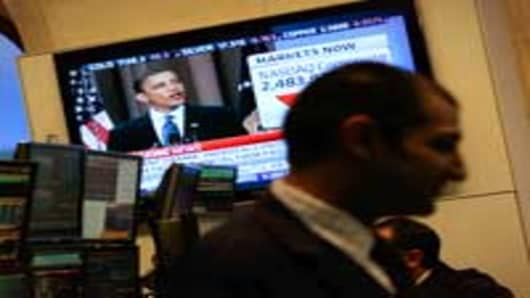Usually, Wall Street can't wait for the midterm elections to be over.
The third year of a first-term presidency brings an impressive stock market rally.
"We haven't had a loss in a third year since 1939 and that's when Nazi Germany invaded Poland," says Jeffrey Hirsch, editor of the Stock Trader's Almanac.
In the five cases involving a Democratic presidency, the market has gained an average of 21.3 percent; in five of six cases involving first-term Republican presidents, the average advance is 10.0 percent.
This year, however, might be different. Either Wall Street is putting the rally ahead of the results or the pattern has yet to unfold.
Stocks are enjoying their best September since FDR was president and are back near the May highs, when the 2009-2010 rally seemed unstoppable.
History Lesson
Data show midterm election years are classic before-and-after case studies for the stock market.
"The before is almost always negative and the after is almost always positive," says Sam Stovall, chief investment strategist at Standard & Poor's.
The S&P 500has typically declined during the months leading up to the mid-term elections for first-term presidents between 1930 and 2006. The Dow Industrialsand Nasdaq Composite have behaved similarly.
"The incumbents try to push through as much as they can the first two years, and its the less palatable issues. Obama is a great example," says Hirsch, ticking off health care reform, financial regulation and fiscal stimulus. "In the second half they try to get re-elected so they start priming the pump."
"You can say everything is different but how the market plays it out is relatively similar."
In the five cases involving a Democratic-controlled Congress, the market has fallen an average of 5.9 percent between July 31 and Oct 31. In the six cases of Republican control, the up/down record is split, but the overall performance is still negative (1.6 percent).
Given that three-month historical track record, October will certainly be a make-or-break month. September's gain has essentially offset August's loss. That's well above the average gain of 1.7 percent in midterm election years.
After a three-week rally, the Dow is now 80 points higher than its Aug. 9 level, which was followed by a 700-point swoon.
Despite its reputation for market crashes, on avearge October is a pretty flat month for the Dow and a modestly higher one for the Nasdaq andS&P 500.
In midterm years, the market has risen 67 percent of the time, with an average gain of 2.6 percent.
Stock Markers
Over the last 75 years, there have been seven changes in leadership in either the House or Senate during midterms. The most recent was 2002, when the GOP took control of the Senate.
Three times control of both houses shifted; in 1946 and 1994, Democrats lost both the House and Senate. The same fate befell the GOP in 1954.
The health of the economy is not as much a factor as people think.
This year most are predicting a change in House leadership, with the GOP picking up at least the 40 seats necessary to tip the scale. The Senate outcome looks closer; the most likely outcome is the Democrats owning a slim majority.
"You have a less accepting legislative body and they have to put through things that are a little more bipartisan," says Hirsch.
Given the enormity of the financial crisis and the recession, as well as the government response to both events, some analysts are questioning whether the model will play out this time around, especially after the massive give-aways of the stmulus plan.
Stovall is not one of them, adding that the market has already performed on cue in the first 18 months of the Obama presidency.
And there's still plenty of time and potential factors to cause a pre-market slump, says Stovall, citing another debt shock from Europe, more disappointmnet about the econony and third-quarter earnings annoucements.
"How many nuclear-war scares have we had, how many Arab oil embargoes have we had?" says Stovall. "You can say everything is different but how the market plays it out is relatively similar."





